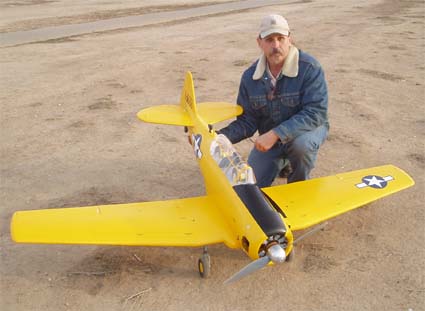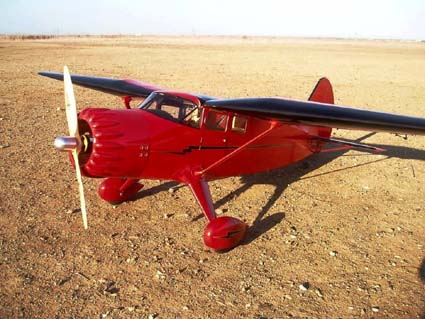 |
Flying High With Electric Power!
The Ampeer ON-LINE!
Fly the Future - Fly Electric! |
Site Table of Contents
| President: | Vice-President: | Secretary/Treasurer: |
| Ken Myers | Richard Utkan | Rick Sawicki |
| 1911 Bradshaw Ct. | 240 Cabinet | 5089 Ledgewood Ct. W. |
| Walled Lake, MI 48390 | Milford, MI 48381 | Commerce Twp., MI 48382 |
| (248) 669-8124 | (248) 685-1705 | 248.685.7056 |
 | ||
| Board of Directors: | Board of Directors: | Ampeer Editor |
| David Stacer | Jack Lemon | Ken Myers |
| 16575 Brookland Blvd. | 8908 Sandy Ridge Dr. | 1911 Bradshaw Ct. |
| Northville, MI 48167 | White Lake, MI 48386 | Walled Lake, MI 48390 |
| 248.924.2324 | 248.698.4683 | 248.669.8124 |
| Mailed Ampeer subscriptions are $15 a year US & Canada and $20 a year world wide. FREE on-line! | ||
| The Next Meeting: Date: Saturday & Sunday, July 12 & 13 Time: 9 a.m. Place Midwest RC 7 Mile Field | ||
|
When subscribing to or renewing the paper version of the Ampeer, please make the check payable to Ken Myers. We do not have a DBA for the Ampeer or EFO. Thanks, Ken Complete except for Speed control and receiver battery. Includes Astro Flight 25G, 7ch Transmitter & receiver Covered with Micafilm and finished with dope Asking $100 Richard Fleming
From John Houvener Midland, MI Ken, Another first for me, I got my first A123 battery the other day. It is the 6-cell 2300. I received it from Model Electroncs Corp (MEC). What a surprise, it comes (the cells) installed in their power tube all set to go. It weighs 17 oz. complete. The price is very good from them.
Thanks for sharing your experiences with us, especially your Li-Po experience. Remember that you can find the latest A123 Systems cell info at homepage.mac.com/kmyersefo/M1-outrunners.htm
Total Performance Factor Questions
Ken, As you probably know by now I am fascinated with cubic wing loading, power loading and other indicators and predictors of flight performance. Your articles on these topics are the most interesting and satisfying to me. Thanks. :-) In the May 2008 Ampeer lead article, you explain that you needed a propeller blade "form factor" to be used in the thrust formula part of your total Performance Factor. As it relates to the Mitch Poling version, you substituted the D/P ratio for the original "1" average value "form factor" but you also added a multiplier of 0.5 without explanation on page 6. The math validates this multiplier being introduced. Should your new form factor be stated as D/2P, both in inches? Does the 0.5 have anything to do with the number of prop blades? |
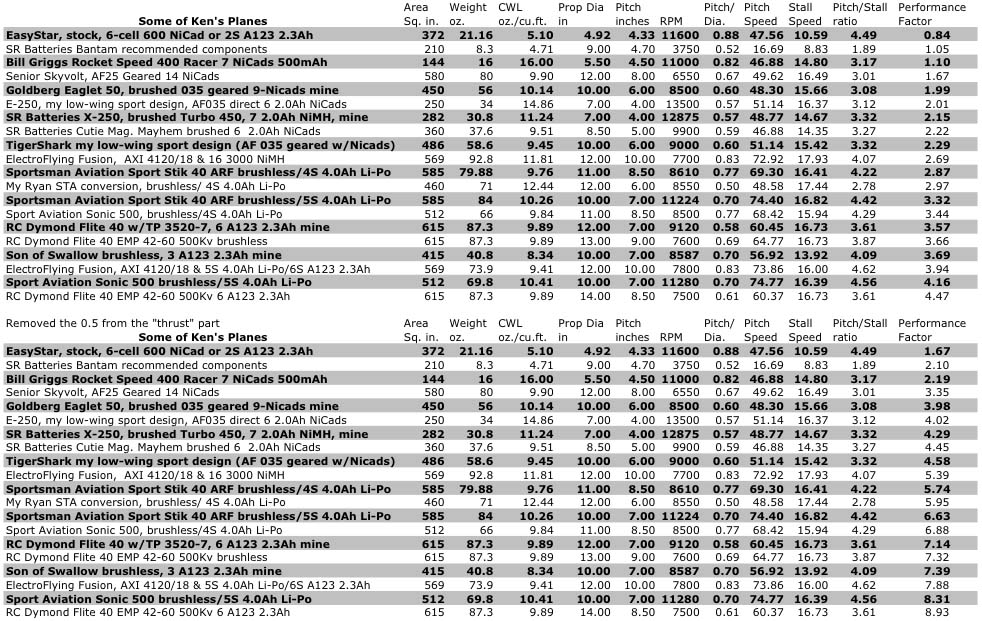
|
Not really. The 0.5 is purely cosmetic. Odd for a math formula isn't it? The tables above show the PF with the cosmetic form factor of 0.5 in the top set of data and without it in the bottom set of data. You should be able to see that it doesn't make a bit of difference when arraigning my planes from least to greatest performance. My PF theory does not take the number of blades into account at all. The vast majority of the data that I have collected is for two bladed props. I hate to be a pest but these things matter to me. Could you please explain? Thanks as always for doing such a great job with the Ampeer. It is my favorite read every month. Never a pest, and boy, do I wish more people would ask such great questions! Hopefully, I've explained it above, and the tables should also make it clearer. It is always great to know that at least some folks are reading my stuff. :-) By the way, I was not sure of what conclusion was to be made of the data table of PF levels at various CWL levels presented at the end of page 6. I believe you are referring to the table where I show the Performance Factors I've found over a large range of electric and glow powered models. I've put the table below, so you can look at the data.
Looking at the spreadsheet, available at metricnewtheory.xls should also help.
More on Large electrics from California
Last month I gave some links to see video of these planes. I asked Don for more information, so here it is. KM Sorry for the delay. My shop has been busy. The P-51 is a Top Flight ARF using an AXI 5345 on 12 Li-Po cells and swinging a 22x12 prop. The same power system is in the Midwest Texan too. The FW 190 is not mine but my friend Denny's. It has a 5330/24 on 10 cells and swings a 20-inch prop, The Stinson Reliant is a built up and spans100". It uses the AXI 5330/24 and swings a 22x12 prop. It flies like a trainer. The P-47 also uses the AXI 5330/24 on 10 cells but I am going to run mine on a AXI 5345 with 12 cells to speed things up some. It is a Hanger 9 ARF. The Pawnee is a nice flying plane. I over powered it with a 5320 and 10 cells to help out with the balance. On 10 cells and a 17x12 prop I can fly about 3, 7 minute flights with throttle control. 
P-51 www.youtube.com/watch?v=KWs8ZfS7xbg
The other video links are: Hangar 9 Pawnee www.youtube.com/watch?v=mQ0WnGHkEdY FW 190 www.youtube.com/watch?v=m3pRFtBAWVE Electrically Powered Beginner Planes: Three Decades With No Real Change
Last year, at the Midwest 5 Mile Rd. flying field I had a chance to help a young man and his father with the boy's first R/C plane. The plane was the HobbyZone Firebird Freedom. They had just picked it up at Joe's Hobby and came out to the field for some instruction. That was a very wise move on their part. The plane is billed by HobbyZone and its distributor, Horizon Hobby, as a "3-channel Teach-Yourself-to-Fly RTF with Anti-Crash Technology".
That is what Scott and Andrew's review tends to "gloss over" but is mentioned if read carefully. 1.) The wing loading/CWL is too high to be an effective trainer; 13.8 oz./sq.ft or 10.9 oz./cu.ft. (advance sport CWL). With this type of loading the plane needs to be flown relatively "fast" to keep it from wallowing and stalling in the turns. It also lands at a higher speed than desirable for a "trainer." This type of loading also requires a forceful, correct hand launch to get it "moving", and a beginner would not know how to do that successfully.
The plane is marketed directly to young fliers looking for "playability." It has the ability to carry X-Port modules aloft with a "bomb" or parachutist drop, lights for night flying or a "combat" module. It is marketed directly to the young flier's parents with a price point under $150 for everything, except the X-Port modules.
Is Balancing 26650 Cells From A123 Systems, Inc. Necessary?
I recently received an email from Walt regarding balancing these cells. Part of that email and my response has been reproduced here. KM WT: I've had some problems recently with my A123s going way out of balance. I was under the impression that if a pack was closely matched they didn't require as frequent balancing as Li-Pos. KM: I've found this to be true. I went downstairs and measured my three packs of these cells. All three packs have been left uncharged since their last flights. The CellMeter-8 was used to read all of the individual cell voltages at the same time. Pack in Fusion: 3.262, 3.268, 3.265, 3.255, 3.274, 3.266 (pack has set for at least 3 weeks since last use)
I charged all three packs. Using the CellMeter-8 I took the individual cell voltage readings about 5 minutes after charge. From my previous experience with these cells, I already knew they would be "all over the place." Pack in Fusion: 3.773, 3.684, 3.730, 3.663, 3.927, 3.942
About 22 hours later, after a nice long rest for the cells to "settle down", I once again read the voltages. I was quite sure they would all be between 3.4v and 3.5v, as this is what I've usually found them to be, but I got a surprise. Pack in Fusion: 3.649, 3.471, 3.492, 3.550, 3.799, 3.813
As you can see, the "little surprise" was the voltage differences in the 6S1P pack used in my Fusion. The other two were exactly what I expected.
Pack in Fusion after run up: 3.496, 3.409, 3.423, 3.458, 3.597, 3.610 This is the biggest variation between cells that I've ever seen. The pack was balanced using the Astro Flight Blinky for A123 cells.
K2 Energy Lithium Iron Phosphate 26650 Cells
K2 Energy provides a Lithium Iron Phosphate type cell. www.peakbattery.com
Here is what K2 Energy says about their 26650 cell:
K2 diameter 27mm, length 65.1mm
Note: The button end is positive on the K2 Energy cells, which is the reverse of the 26650 from A123 Systems, Inc. 3S1P Pack weights: Cells #1, #2, and #3 were made into a pack using 2 APP connectors, power leads, node/balance leads, tape and hook and loop fastener strips. Everything was done to duplicate, as closely as possible, the A123 pack I've been using.
The new K2 Energy pack was first charged at 2.5 amps (1C) using an unmodified AF109 charger with termination done manually with the resting cell voltages being 3.732, 3.738, 3.719 about an hour and a half after the initial charge. The pack was discharge using the AF 109. The pack was then charged at 5 amps (2C) and 2.526AH was returned to the pack in 32 minutes, again terminating manually. The pack was discharged using the AF 109. The pack was then charged at 7.5 amps (3C) in 21 minutes with 2.492Ah returned to the pack. The pack sat overnight. In the morning, I was very surprised to see the Cellmeter-8 read all three cells' voltages exactly the same at 3.334v!
| ||||||||||||||||||||||||||||||||||||||||||||||||||||||||||||||||||||||||||||||||||||||||||
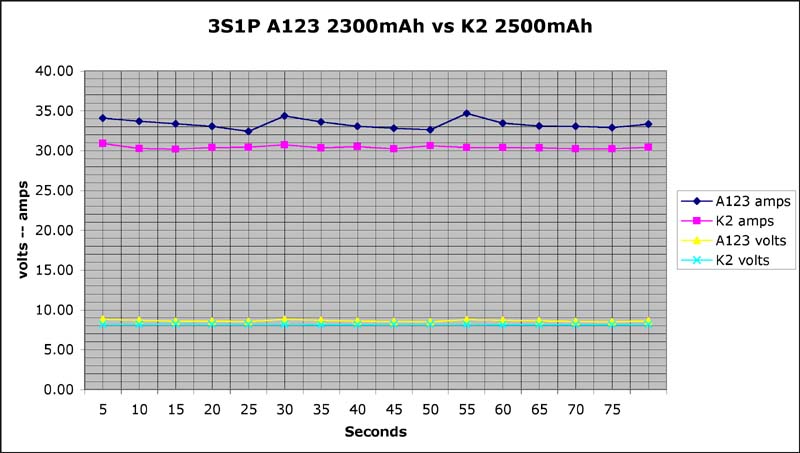
| Averages for 5 through 75 seconds:
A123: 8.61v, 33.33 amps, 8602 RPM K2:8.14v, 30.39 amps, 8216 RPM For a plane that flies on the wing, like the Son of Swallow, pitch speed is a good indicator of relative performance. The average pitch speed for the 10x7 was using the A123 cells is 57 mph, while for the K2 pack it is 54.5 mph. I statically evaluated a 10x8 Master Airscrew standard wood prop. With the K2 pack, the average numbers are: 7.96v, 34.7 amps, 7620 RPM
I do not have any onboard data gathering system. I first flew the SOS using the A123 pack to "get the feel" of the plane again fresh in my mind. I landed, immediately changed the pack, and flew the K2 pack. The K2 pack required a higher throttle setting in level flight to feel the same and was just a little off in the vertical, yet still good, just not quite as good as the A123 pack. The K2 pack was charged and the prop changed to the Master Airscrew 10x8 standard wood. The plane felt very much the same in the air. The speed and vertical "felt" at least as good as with the A123 pack and 10x7 prop.
|
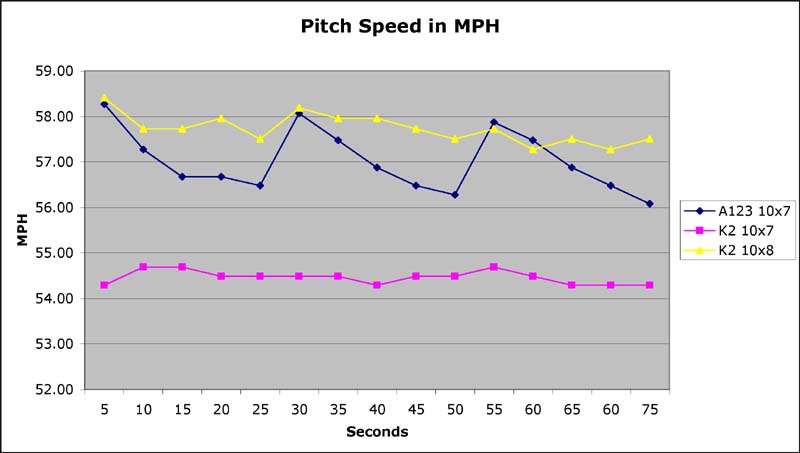
|
I found that both the A123 pack and K2 pack "put out more" when warm, this is very similar to what I found and presented in my article "Effects of Temperature On the Battery". homepage.mac.com/kmyersefo/temperature.htm I will continue to fly the SOS using the K2 3S1P pack and Master Airscrew 10x8 standard wood prop to check the life of the K2 cells. I will also be charging them at 7.5 amps, as waiting longer than 20 minutes is "just too long", when at the field! This should provide a good "torture test" for them as well. I have complete data and more graphs available in my article about the K2 Energy Cells at homepage.mac.com/kmyersefo/K2.htm. Sanyo Eneloop NiMH Cells
Sanyo has a cell they call the eneloop. It is a NiMH type cell with some very interesting characteristics. www.eneloopusa.com/eneloop.html

Graphic from Sanyo Site noted above I have replaced the 8-cell Sanyo NiCad 700mAh pack in my Hitec Eclipse 7 transmitter with an 8-cell eneloop pack that I purchased from Robotic Power Solutions, (AKA www.battlepack.com). I now have almost three times the capacity, and I can charge when convenient, and not worry if my transmitter is ready to go.
|
To Reach Ken Myers, you can land mail to the address at the top of the page. My E-mail
address is:
KMyersEFO@mac.com
EFO WEBsite: http://members.aol.com/KMyersEFO/
